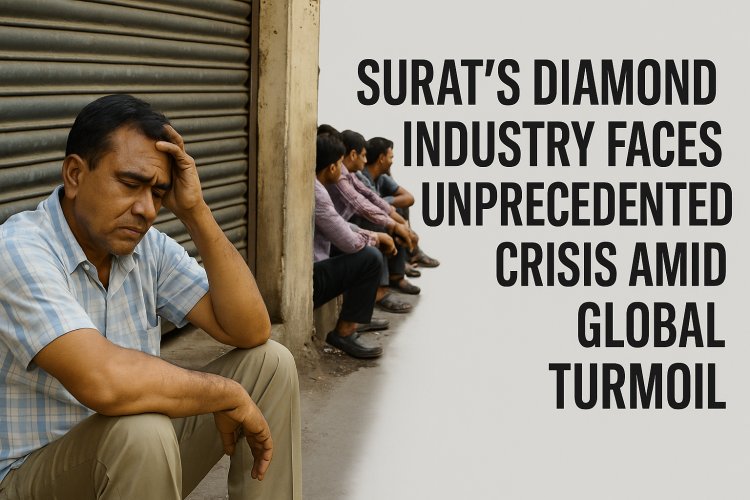Surat’s Diamond Industry in Crisis: Factory Closures, Job Losses, and Falling Demand
Surat’s diamond industry faces a severe downturn with widespread factory closures, massive job losses, and shrinking global demand. Discover the causes and implications of this economic crisis

Surat at a Crossroads: Diamond Industry Faces Deepening Crisis as Tech Sector Rises
Surat, the world’s largest diamond polishing hub, is facing an unprecedented crisis. Nearly 20-25% of diamond units remain shut after Diwali, with falling global demand, rising synthetic diamond competition, and economic slowdowns pushing the industry into turmoil. Thousands of workers have lost jobs, and small-scale factories struggle to survive.
This report compiles insights from industry experts, CEOs, and workers to understand the depth of the crisis and its implications for India’s diamond capital.
Surat’s Diamond Industry Faces Unprecedented Crisis Amid Global Turmoil
Surat, often hailed as the world's diamond polishing capital, is grappling with a severe downturn that has left its once-thriving industry in distress. The city, responsible for processing approximately 90% of the world's diamonds, is witnessing factory closures, massive job losses, and a ripple effect impacting various sectors.
A Declining Sparkle: The Economic Downturn
The diamond industry in Surat has been on a downward trajectory for over two years. Factors such as the global economic slowdown, declining demand in key markets like the U.S. and China, and the rise of lab-grown diamonds have contributed to this decline. Notably, the U.S. imposed a 10% import tariff on Indian diamonds, with potential additional levies looming, further straining the sector.
Exports of cut and polished diamonds from India dropped by 27.58% to $15.97 billion in FY24. Simultaneously, imports of rough diamonds declined by 17.85%, indicating reduced manufacturing activity.
Human Cost: Job Losses and Suicides
The industry's downturn has had a profound human impact. Over 30,000 workers have lost their jobs in the past six months alone. Tragically, the Diamond Workers' Union reports that 65 workers have died by suicide over the past 18 months, underscoring the crisis's severity.
Families like that of Vinubhai Parmar, a diamond polisher who lost his job, are struggling to make ends meet. Parmar expresses despair over his inability to support his children's education and basic needs.
Broader Economic Impact: Real Estate and Beyond
The diamond industry's slump has had a cascading effect on Surat's real estate sector. New construction approvals have dropped from 724 in 2022-23 to 553 in 2024-25. The decline in diamond-related income has led to reduced demand for housing, affecting developers and related businesses.

The Scale of the Crisis In Surat
1. Factory Closures and Job Losses
-
According to Hindustan Times, 20-25% of diamond units in Surat have not reopened after Diwali.
-
The Economic Times reports that over 8,000 workers have been laid off in the past six months.
-
Small and medium factories, which employ nearly 700,000 workers, are the worst hit.
2. Falling Global Demand
-
The BBC highlights that weak demand in the U.S. and China, the two biggest diamond markets, has led to a 30% drop in orders.
-
The Hindu reports that lab-grown diamonds (LGDs) are eating into natural diamond sales, with prices dropping by 50-60% in the last two years.
3. Surat Diamond Bourse Struggles
-
The interview with Mahesh Gadhvi, CEO of Surat Diamond Bourse, reveals that high inventory costs and liquidity crunch are major challenges.
-
Many traders are holding onto unsold stock, unable to recover costs due to falling prices.
Root Causes of the Surat Diomond Industry Crisis
1. Economic Slowdown in Key Markets
-
The U.S. and China, which account for 65% of global diamond demand, are cutting back on luxury spending due to inflation and economic uncertainty.
2. Rise of Lab-Grown Diamonds (LGDs)
-
The India Today report states that cheaper synthetic diamonds are disrupting the market, with major retailers like De Beers and Pandora shifting focus to LGDs.
-
Natural diamond prices have crashed, making it unviable for Surat’s small polishers.
3. Geopolitical Factors & Russian Sanctions
-
The Economic Times notes that sanctions on Russian diamonds (which supply 30% of the world’s rough diamonds) have disrupted supply chains.
-
The G7’s ban on Russian diamonds has forced Surat’s industry to find alternative sources, increasing costs.
4. High Debt and Liquidity Crunch
-
Many diamond units operate on high-interest loans, and with falling sales, they are unable to repay creditors.
-
The Hindustan Times reports that banks are reluctant to lend, worsening the liquidity crisis.3
Impact on Workers and Businesses in Surat
1. Mass Layoffs and Wage Cuts
-
Workers, mostly migrants from Saurashtra and Odisha, are returning home as factories cut shifts.
-
Daily wages have dropped from ₹800-1,000 to ₹500-600
The crisis has had a devastating impact on diamond workers in Surat:
- Job Losses: Lakhs of workers have lost their jobs, with many factories remaining closed.
- Wage Reductions: Average daily wages have fallen drastically.
- Financial Hardship: Many workers are struggling to make ends meet, leading to increased stress and, in tragic cases, suicides.
- School Dropouts: Some families have been forced to withdraw their children from school due to financial constraints.
2. Fear of Permanent Shutdowns
-
The BBC quotes a factory owner saying, “If demand doesn’t recover in 6 months, 50% of Surat’s units may shut forever.”
3. Psychological Toll on Traders
-
India Today highlights rising stress and suicides among small traders unable to repay loans.
Government and Industry Response: Government Intervention Support Package Announced
In response to the escalating crisis, the Gujarat state government has unveiled a support package aimed at alleviating the industry's woes. Key measures include:
Educational Support: Full reimbursement of school fees up to ₹13,500 per child annually for children of unemployed diamond artisans.
Financial Aid for Units: Interest subsidies on term loans up to ₹5 lakh at 9% interest for three years and electricity duty exemptions for one year starting July 1, 2025.
Eligible artisans must apply within two months, providing necessary documentation to the District Industries Centre.
1. Calls for Policy Support
-
The Gujarat government has been urged to provide tax relief and subsidies to diamond units.
-
The Surat Diamond Association is seeking export incentives to compete with LGDs.
2. Shift Towards Lab-Grown Diamonds?
-
Some units are transitioning to synthetic diamonds, but this requires new machinery and skills.
3. Long-Term Survival Strategies
-
Mahesh Gadhvi suggests diversification into jewelry manufacturing to reduce dependency on polishing.

Historical Significance and Current Challenges
Surat's dominance in the diamond industry began in the early 20th century, driven by lower cutting costs and a unique business model. However, the industry is now facing unprecedented challenges.
Key Issues and Factors Contributing to the Crisis:
- Global Economic Downturn: A slowdown in key markets like the US, Europe, and China has significantly reduced the demand for diamonds.
- Geopolitical Tensions: The Russia-Ukraine war has disrupted the supply of rough diamonds, as Russia is a major supplier. Sanctions on Russian diamonds have further complicated the situation.
- Competition from Lab-Grown Diamonds: The rise of lab-grown diamonds, particularly from China, is affecting the market for natural diamonds. These synthetic diamonds are cheaper and increasingly popular.
- Falling Exports: India's diamond exports have declined significantly, from $25.48 billion in 2021-22 to $18.37 billion in 2023-24.
- Factory Closures and Job Losses: Many diamond processing units in Surat have been forced to shut down, leading to widespread job losses. Estimates suggest that lakhs of workers have lost their jobs.
- Reduced Wages: Workers who are still employed have experienced substantial wage cuts.
- Financial Distress and Suicides: The economic hardship has led to severe financial distress among workers, with reports of suicides due to job losses and inability to meet basic needs.
- Surat Diamond Bourse struggles: Despite being the world's largest office complex, the Surat Diamond Bourse is facing slow occupancy, reflecting the overall downturn in the industry.
Industry Voices and Hopes
Veterans like Lalji Patel, chairman of Dharmanandan Diamonds, and Govindbhai Dholakia, chairman of Shree Ram Krishna Exports, have called for patience and resilience, expressing hope for a turnaround. However, industry leaders acknowledge that this recession is unprecedented in its length and severity
Dinesh Navadia, chairman of the Indian Diamond Institute, has called for government intervention—suggesting relief on loan EMIs, school fees, and medical benefits for struggling workers.

A Surprising Shift: Surat’s SaaS and Tech Boom
Amid the gloom in diamonds, Surat is witnessing a quiet but remarkable transformation in its technology landscape. The city, once synonymous with diamonds and textiles, is emerging as a new hub for software-as-a-service (SaaS) startups Over 160 software-based startups have sprung up, supported by a strong local talent pool, lower operational costs, and an entrepreneurial mindset.
Startups like Dhiwise, Trezix, and Ezee are scaling rapidly, attracting tech talent from established centers like Pune, Mumbai, and Bengaluru. This shift signals a broader change in India’s tech geography, with Tier 2 cities like Surat poised to play a bigger role in the nation’s digital economy
Surat Diamond Bourse: World's Largest Office Building Remains Mostly Vacant Amid Industry Crisis
The Surat Diamond Bourse (SDB), inaugurated with much anticipation by Prime Minister Narendra Modi on December 17, 2023, has quickly become a symbol of the challenges facing India's diamond industry. Despite being the world's largest office building—surpassing even the Pentagon—all 4,200 of its offices have been sold, but only about 150 are currently operational, leaving the vast majority of the complex eerily empty.
However, the reality has not matched expectations. The diamond industry in Surat, which cuts and polishes the majority of the world’s diamonds, is grappling with a severe downturn. This has dampened the willingness of businesses to relocate from established hubs in Mumbai and Surat’s older markets to the new bourse.
Despite the bleak outlook, SDB president Nagji Sakariya has emphasized the comprehensive infrastructure and services in place to support diamond-related operations. Management remains hopeful that as connectivity and ancillary services improve, more businesses will occupy the bourse and help revive Surat’s diamond industry.
The Surat Diamond Bourse stands as both a testament to the city’s ambitions and a stark reminder of the volatility of the global diamond trade. Until international demand recovers and the industry adapts to new consumer trends and technologies, the world’s largest office building may continue to operate far below its intended capacity.
Conclusion: Can Surat Regain Its Shine?
Surat’s diamond industry, once a symbol of India’s global craftsmanship, is at a crossroads. Without urgent policy intervention, financial support, and adaptation to lab-grown diamonds, the crisis could deepen, risking half a million jobs.
The next few months will be critical in determining whether Surat can reinvent itself or face an irreversible decline in the global diamond trade.
Read Similar News Below:

 Editor
Editor 






























